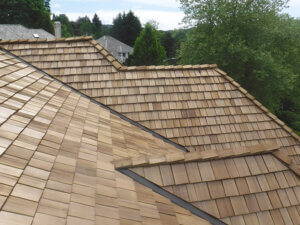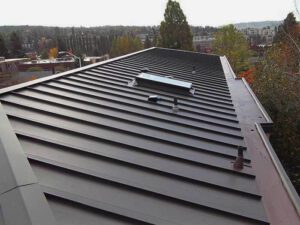When you decide that it’s time to replace your roof, you want to make sure you get the most out of your investment. That means choosing a roofing material that has a long lifespan. If you’ve been wondering what type of roof lasts longest, our experts at Larry Haight’s Residential Roofing Company can help guide you to make the best decision for your home.
We’ve outlined the lifespan of different roofing materials below, so you can go into your roof replacement project with all the knowledge you need to make the right decision for your home. If you have any questions as you plan your roofing project, please reach out to us by calling 425-881-9771 or contacting us online.
What Type of Roof Lasts Longest? Comparing Different Materials
Our roofing experts install a variety of different roofing materials to help protect your home against the elements. Learn more about the lifespan of each option below.
Composition Roofing: About 15 to 40 Years
Composition roofing, which is made from a combination of fiberglass, granules, and asphalt, is one of the most popular roofing materials on the market. How long your composition roofing lasts will largely depend on the type of shingles you choose.
Dimensional shingles are more durable than 3-tab composition shingles, while luxury shingles are the most durable. With a high-end composition roofing option, you can expect your roof to last around 40 years.
PVC Membrane Roofing: About 20 to 30 Years
Made from polyvinyl chloride, PVC membrane roofing is predominantly used for flat or low-slope roofs. Known for its durability, flexibility, and resistance to chemicals and fire, PVC is a popular choice for commercial buildings but is also suitable for residential homes with flat roofs.
PVC membrane roofing can last between 20 and 30 years, with some premium products extending closer to 40 years. The material is also resistant to moisture and chemicals, which makes it ideal for areas with heavy rain or snow. While not as long-lasting as metal or synthetic roofing options, its performance in specific conditions makes it a reliable choice for flat roofs.
Larry Haight Roofing highlights PVC membrane roofs for their efficiency in weather-proofing flat roofs, providing effective solutions for homes and commercial properties alike. They note the material’s resistance to ponding water, a common issue with flat roofs.
Cedar Shake Roofing: About 25 to 30 Years
Cedar shake roofing is a traditional material known for its rustic charm and natural beauty. Hand-split from cedar logs, cedar shakes are thicker than cedar shingles, offering better insulation and durability. However, this material requires regular maintenance to achieve its full lifespan.
On average, cedar shake roofs can last 20 to 40 years when well-maintained. Higher-quality cedar and proper installation can extend this to 50 years. However, cedar roofs are more vulnerable to moisture, which can lead to mold, moss growth, and rot if not properly treated. Regular cleaning and inspections are necessary to ensure the longevity of cedar shakes, especially in wet climates like the Pacific Northwest.
At Larry Haight Roofing, cedar shake is considered a premium option due to its natural beauty and ability to withstand wind and storm damage. However, its higher maintenance demands make it more suited for homeowners who are committed to regular upkeep.
Synthetic Roofing: About 40 to 50 Years
Synthetic shake roofing is designed to replicate natural materials such as slate and wood shakes but come with significant advantages in terms of durability and maintenance. Made from a combination of rubber, plastic, and other synthetic compounds, these materials offer the aesthetic appeal of natural roofing without the drawbacks of frequent upkeep.
Synthetic roofing materials are particularly durable, with a lifespan that can exceed 50 years. Unlike natural wood or slate, synthetic roofing doesn’t warp, crack, or rot and is resistant to insects and fire. High-quality synthetic shakes even come with Class A fire ratings and Class 4 impact resistance, ensuring they stand up to extreme weather conditions.
Larry Haight Roofing offers synthetic roofing as an eco-friendly and low-maintenance option, especially for homeowners who love the look of cedar shakes or slate but want a material that lasts longer without frequent repairs.
Metal Standing Seam Roofing: About 50 to 75 Years

Metal standing seam roofing has the longest average lifespan of any material we use. There are many metal roof benefits, and thanks to the interlocking panels, which are made from high-quality metals like copper, aluminum, and steel, a metal roof can withstand various weather extremes and require very little maintenance.
The lifespan of a metal roof is greatly influenced by the material used and installation quality. Aluminum and steel are common and more affordable options, while copper offers a premium finish and exceptional durability. Metal roofs are resistant to fire, wind, and insect damage, making them suitable for a wide range of climates.
At Larry Haight Roofing, metal roofs are often recommended for their energy efficiency and durability. Metal roofs reflect solar heat, reducing cooling costs during the summer months, and they are also resistant to extreme weather, making them a great choice for homeowners looking for a long-term solution. With an average lifespan between 50 and 75 years, metal roofs offer an average ROI of around 43.4%.
What Affects the Lifespan of Your Roof?
While the material you choose has the biggest impact on the lifespan of your roof, there are a few other factors that will play a role in how long you can expect your new roof to last. Let’s explore them more below:
- Climate: Our wet climate here in Washington can take a toll on your roof, eventually leading to mold growth and rot. Additionally, freezing and thawing temperatures in the winter can put a strain on your roof.
- Maintenance: Keeping up with a regular maintenance and inspection routine can help your roof last longer, no matter what material you choose.
- Installation: If your roof isn’t installed correctly from the beginning, it will be more prone to damage over time, causing it to degrade faster. Choosing an experienced roofing contractor like Larry Haight’s Residential Roofing Company can help you get the most out of your roof.
- Ventilation: Poor roof ventilation can lead to a buildup of heat beneath your shingles, causing them to age faster than normal. Ensure you have proper ventilation to help your roof last longer.
- Gutters: Proper gutter maintenance is essential for maximizing your roof’s lifespan. Neglecting them can lead to premature damage and costly roof replacements.
Which Roof Material is Right For You?
When choosing a roofing material, understanding the longevity and maintenance requirements is crucial. Depending on what stage of life you are at and what your intentions are, the type of roof you choose is a big deal. Seniors need to balance cost vs long term maintenance. Metal and synthetic roofs offer the best long-term value, with lifespans of over 50 years, making them ideal for homeowners looking for minimal maintenance. Cedar shakes provide timeless beauty but require regular upkeep to achieve their full lifespan of up to 50 years. Composite roofing offers a balance between durability and aesthetic appeal, with a lifespan of 40 to 50 years, while PVC membrane roofing is a solid choice for flat roofs, lasting around 20 to 30 years.
Install a Roof Designed to Last
After learning more about what type of roof lasts longest, we hope you feel more prepared to choose the right material for your roof replacement. To learn more about the different materials we install or request a free quote, please call 425-881-9771 or contact us online.
Additional Resources





